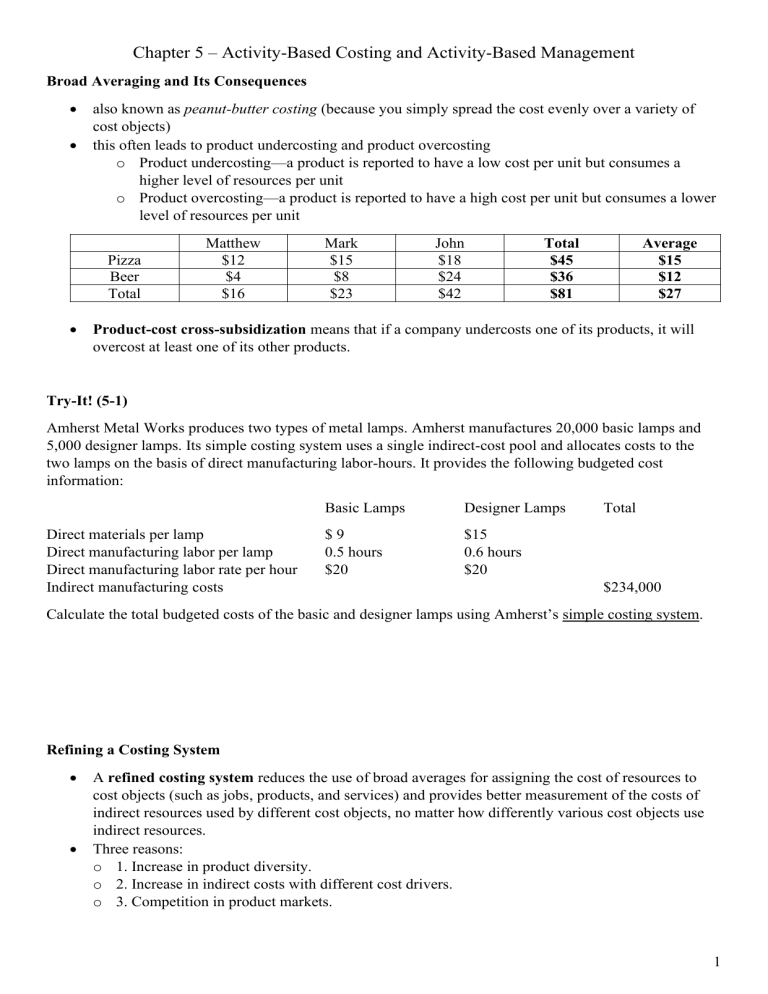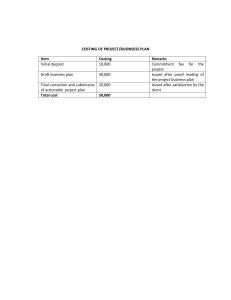
Chapter 5 – Activity-Based Costing and Activity-Based Management Broad Averaging and Its Consequences • • also known as peanut-butter costing (because you simply spread the cost evenly over a variety of cost objects) this often leads to product undercosting and product overcosting o Product undercosting—a product is reported to have a low cost per unit but consumes a higher level of resources per unit o Product overcosting—a product is reported to have a high cost per unit but consumes a lower level of resources per unit Pizza Beer Total • Matthew $12 $4 $16 Mark $15 $8 $23 John $18 $24 $42 Total $45 $36 $81 Average $15 $12 $27 Product-cost cross-subsidization means that if a company undercosts one of its products, it will overcost at least one of its other products. Try-It! (5-1) Amherst Metal Works produces two types of metal lamps. Amherst manufactures 20,000 basic lamps and 5,000 designer lamps. Its simple costing system uses a single indirect-cost pool and allocates costs to the two lamps on the basis of direct manufacturing labor-hours. It provides the following budgeted cost information: Direct materials per lamp Direct manufacturing labor per lamp Direct manufacturing labor rate per hour Indirect manufacturing costs Basic Lamps Designer Lamps $9 0.5 hours $20 $15 0.6 hours $20 Total $234,000 Calculate the total budgeted costs of the basic and designer lamps using Amherst’s simple costing system. Refining a Costing System • • A refined costing system reduces the use of broad averages for assigning the cost of resources to cost objects (such as jobs, products, and services) and provides better measurement of the costs of indirect resources used by different cost objects, no matter how differently various cost objects use indirect resources. Three reasons: o 1. Increase in product diversity. o 2. Increase in indirect costs with different cost drivers. o 3. Competition in product markets. 1 Guidelines for Refining a Costing System 1. Direct-cost tracing – Identify as many direct costs as is economically feasible. 2. Indirect-cost pools – Expand the number of indirect-cost pools until each pool is more homogeneous. All costs in a homogeneous cost pool have the same or a similar cause-and-effect (or benefits-received) relationship with a single cost driver that is used as the cost-allocation base. • e.g., machining costs (cost driver: machine-hours) should be a separate pool from distribution cost (cost driver: cubic feet of product delivered) 3. Cost-allocation bases – As we describe later in the chapter, whenever possible, managers should use the cost driver (the cause of indirect costs) as the cost-allocation base for each homogeneous indirect-cost pool (the effect). Activity-Based Costing • • Activity-based costing (ABC) refines a costing system by identifying individual activities as the fundamental cost objects. An activity is an event, task, or unit of work with a specified purpose—for example, designing products, setting up machines, operating machines, or distributing products. Example: A company produces 60,000 simple lenses and 15,000 complex lenses. One batch of production can produce 240 simple lenses or 50 complex lenses. It takes 2 hours to set up a batch of simple lenses, and 5 hours to set up a batch of complex lenses. Given that setup costs amount to $300,000, how much of the setup costs should be allocated to the simple lenses and the complex lenses? Compare the results if the company used simple costing based on direct labor-hours (simple lenses: 30,000 hours; complex lenses: 10,000 hours; setup cost per direct labor-hours: $7.50). Cost Hierarchies • 1. 2. 3. 4. A cost hierarchy categorizes various activity cost pools on the basis of the different types of cost drivers, cost-allocation bases, or different degrees of difficulty in determining cause-and-effect (or benefits-received) relationships. Output unit-level costs are the costs of activities performed on each individual unit of a product or service. (e.g., machine operating costs – energy, depreciation, repairs) Batch-level costs are the costs of activities related to a group of units of a product or service rather than each individual unit of product or service. (e.g., setup costs per batch, material-handling and quality-inspection costs associated with batches, costs of placing purchase orders) Product-sustaining costs (service-sustaining costs) are the costs of activities undertaken to support individual products or services regardless of the number of units or batches in which the units are produced or services provided. (e.g., design costs, marketing costs on product launches, R&D costs) Facility-sustaining costs are the costs of activities that managers cannot trace to individual products or services but that support the organization as a whole. (e.g., general administration costs – top management compensation, rent, building security) 2 Activity-Based Management • Activity-based management (ABM) is a method of management decision making that uses activitybased costing information to improve customer satisfaction and profitability. o Pricing and Product-Mix Decisions o Cost Reduction and Process Improvement Decisions o Design Decisions o Planning and Managing Activities Try-It! (5-2) Amherst Metal Works produces two types of metal lamps. Amherst manufactures 20,000 basic lamps and 5,000 designer lamps. Its activity-based costing system uses two indirect-cost pools. One cost pool is for setup costs and the other for general manufacturing overhead. Amherst allocates setup costs to the two lamps based on setup labor-hours and general manufacturing overhead costs on the basis of direct manufacturing labor-hours. It provides the following budgeted cost information: Direct materials per lamp Direct manufacturing labor-hours per lamp Direct manufacturing labor rate per hour Setup costs Lamps produced per batch Setup-hours per batch General manufacturing overhead costs Basic Lamps Designer Lamps $9 0.5 hours $20 $15 0.6 hours $20 Total $114,000 250 1 hour 50 3 hours $120,000 Calculate the total budgeted costs of the basic and designer lamps using Amherst’s activity-based costing system. 3 4





